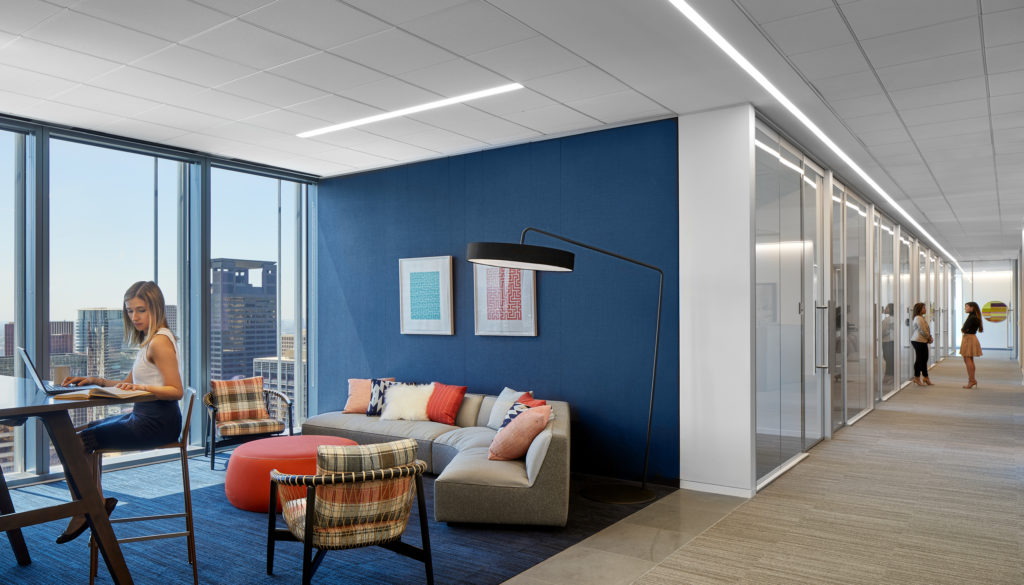
Now that authorized COVID-19 vaccine distribution has arrived in the U.S., the end of a very long and dark tunnel has been illuminated. In the next several months, the hope is we can get back to our full daily lives and safely return to the office. To that end, has the future of the legal workplace been illuminated as well?
The Gensler Research Institute has released its third U.S. Workplace Survey of the year, building on the first report released prepandemic and the second report a couple of months into the widespread “work from home” orders. These results, along with those of the recently released third survey, are helping to inform how we design the legal workplace and others moving forward.
What we learned from insights of more than 2,300 individuals across 10 industries is that workplace design trends, and specifically workplace trends in the legal industry identified prior to the pandemic, will continue accelerating, and in a more impactful way than ever before in the legal environment.
Not only has COVID-19 forced firm leaders to rethink their office landscape, but how they work. The numbers point toward a work model that encourages and supports the increase of collaboration and remote working. The findings also suggest that a thoughtful reduction in square footage can continue to accommodate employees in this new way of working with more dynamic seating choices.
Solidifying the Hybrid Work Model
One of the most significant survey findings shows that 56% of U.S. lawyers would prefer the flexibility of a hybrid work model, balancing days working in the office with days working from home. While 59% still want to be in the office most of the time, practitioners generally desire more choice in where they work.
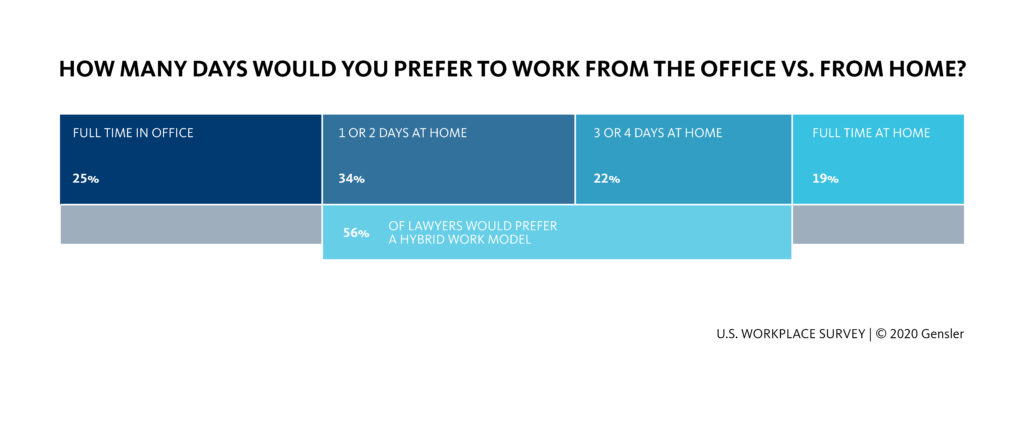
As a result, working from home has raised the bar on the legal workplace. Lawyers surveyed prepandemic spent 58% of their day on focus work. Today focus time has increased to 71% when working full time from home. If time spent on focus work is higher at home than in the office, and if firms begin to follow hybrid work models, then as designers have to ask ourselves, “What is it that will drive lawyers to the office?”
For the answer, we must look at which tasks can’t be done well at home. According to the findings, while focus time is up in the work-from-home model, collaboration has notably decreased. Collaborating with colleagues for learning, socializing, mentoring and reinforcing firm culture are still integral to productivity, growth, innovation and profitability. Therefore, offices are still essential. However, they need a design that can support more hybrid work and function as a platform that encourages and strengthens collaboration.
Collaboration is King
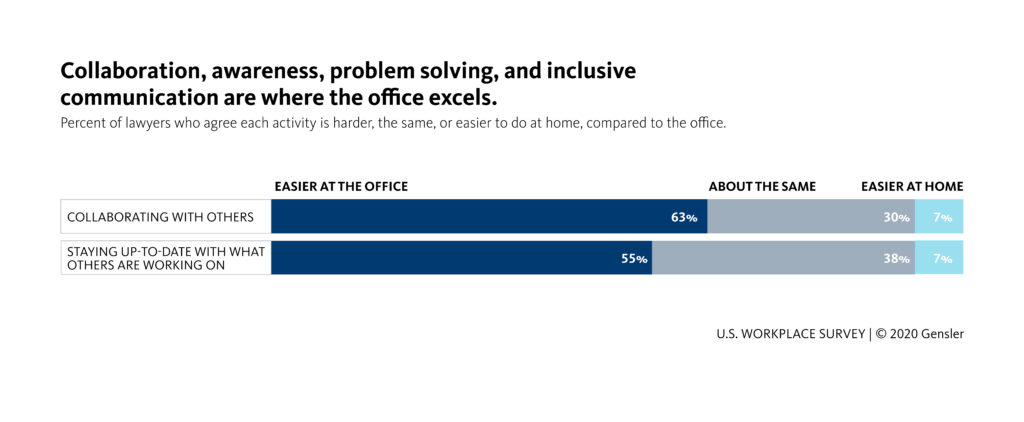
What we have seen across all industries, and is true for the legal industry as well, is that collaboration has been increasing over time. We expect to see this trend increase significantly following the return to the office after the pandemic.
In prior years we have seen incremental increases in collaboration of about 2% per year, on average.
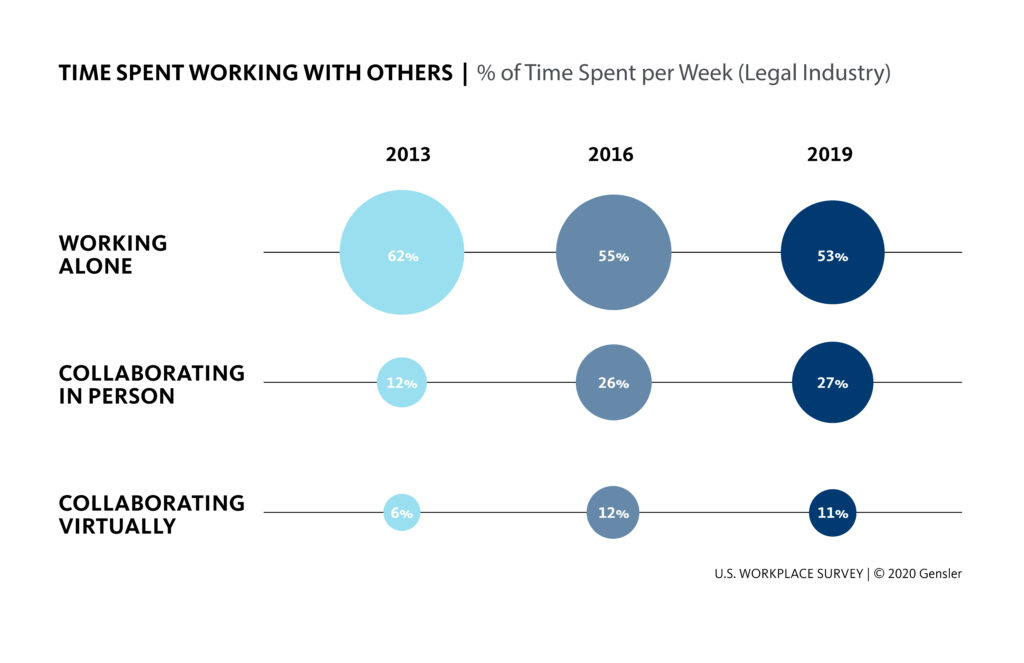
What’s become clear across all industries is that in-person collaboration, has increased from 29% prior to the pandemic up to 43% for those that have returned to the office full time. This is by far, the greatest increase in in-person collaboration we’ve seen in recent years.
The Trade-off for Private Space
Looking deeper into the findings, we see an increased desire for private space. While this might not be surprising for lawyers to hear, the number of lawyers who would consider unassigned seating as a trade-off for added flexibility is unexpected.
Our research shows the majority of lawyers want an assigned, permanent desk. However, we also see that 31% would share their workspace with others if given the opportunity to spend more time working remotely. This has a huge impact on the overall real estate required. If the nearly a third of lawyers who will consider unassigned seating in exchange for flexibility are coupled with 41% who want to work remote three or more days per week, firms may no longer need to provide a 1-to-1 seating ratio of lawyer to lawyer offices.
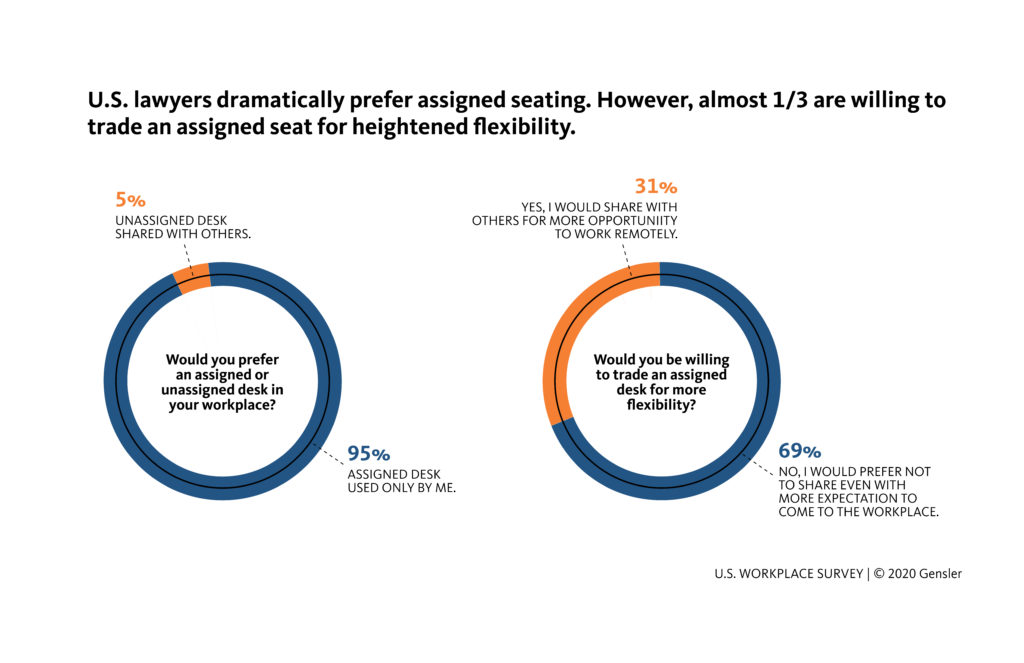
The New, Big Picture
With more lawyers wanting a hybrid work style, more firms are considering smaller, universal-sized offices for all attorneys, rather than a traditional layout with the standard two sizes of offices, for partners and associates. These universal offices can be designed as compact, higher performing workspaces. Even if all offices are assigned, firms can still recognize an incremental reduction in real estate by implementing universal offices as a standard. Universal offices are also likely to be better leveraged regardless, because of the increased flexibility from a facilities standpoint.
If firms plan their initial space with 1-to-1 seating for lawyers to lawyer offices, they can potentially accommodate growth by sharing offices that have become underutilized, because more lawyers are working remote, for firm growth rather than building additional offices. Utilizing this strategy, firms may no longer need to include expansion options in a new lease, reducing the rentable square feet per attorney and overall real estate footprint in future legal workplaces.
While law firms have been traditionally conservative when it comes to adopting new workplace trends, they also don’t like paying for underutilized space. Firms were exploring options to decrease their space requirements prepandemic, but today this conversation has been elevated, especially as they consider embracing the hybrid work model. The transition to this model is made easier with new, seamless technology already tested while firms work for home and with additional tools to manage room reservations and other facility requirements. The challenge now for each firm is to determine their leveraged model and the right ratio of unassigned offices.
Finding the sweet spot for individual firms, over the course of a 10-, 12- or 15-year lease may be a little like Goldilocks and the Three Bears. Firms will want to make sure that they push enough but don’t overcorrect. Gensler’s Workplace Survey data provides parameters that every firm can utilize to curate a workplace solution that best fits their culture, personality and firm values, and serves them well for many years to come.

Kenneth Wiesehuegel is an architect and registered interior designer and studio director in the Houston office of global design firm, Gensler. Kenneth has 34 years of experience designing and managing law firm projects and currently serves as the Regional Leader for Workplace – Professional Service Firms.
